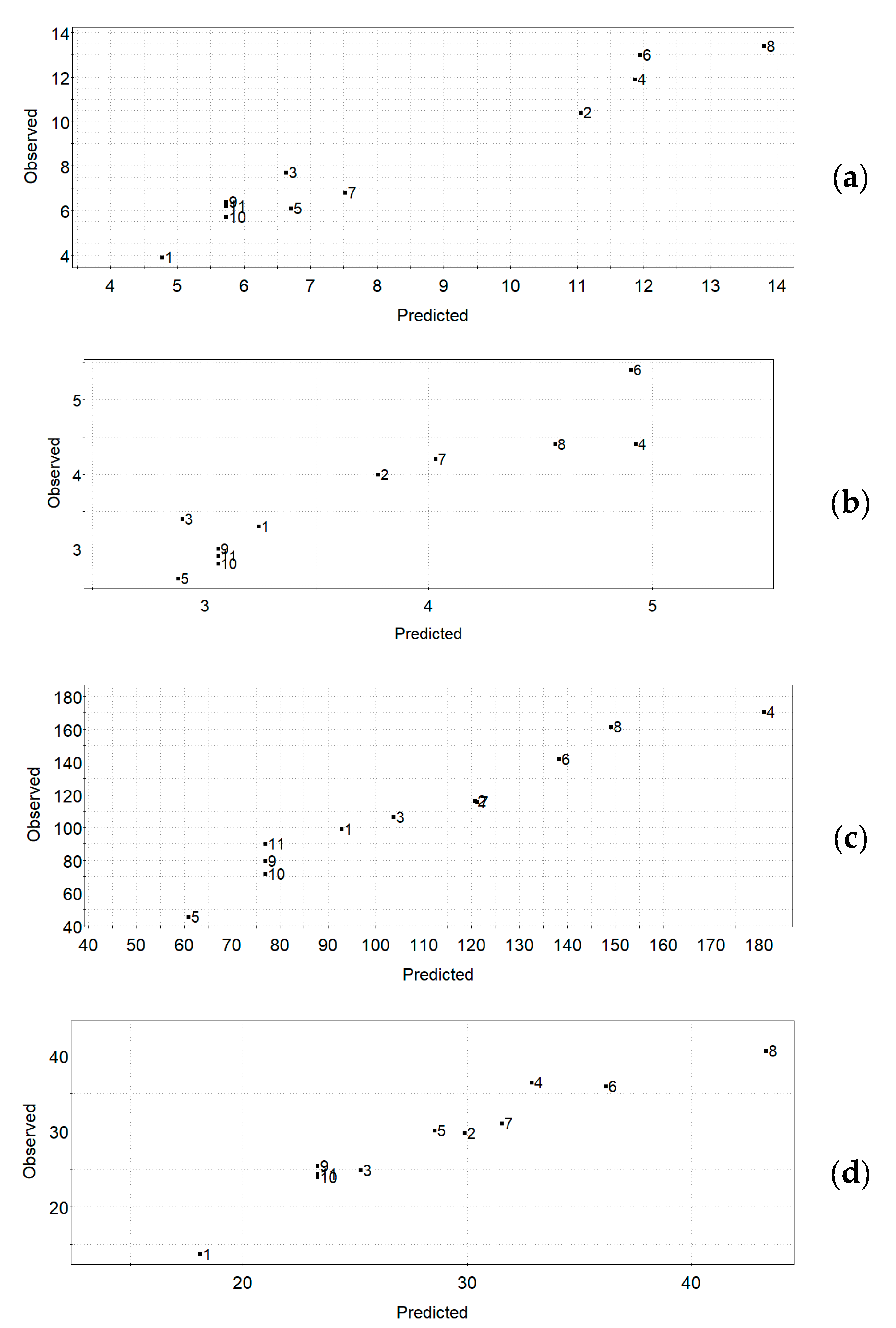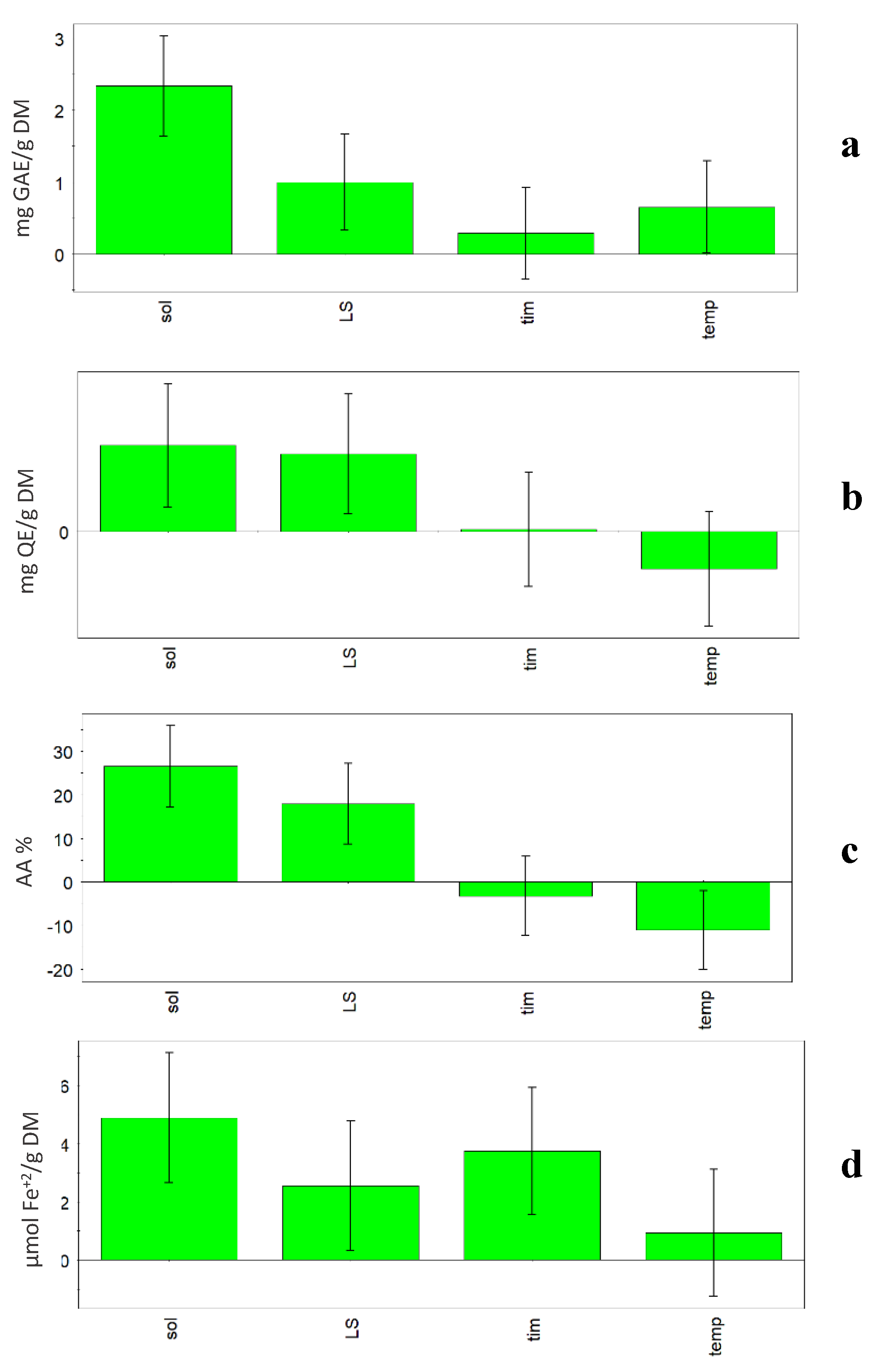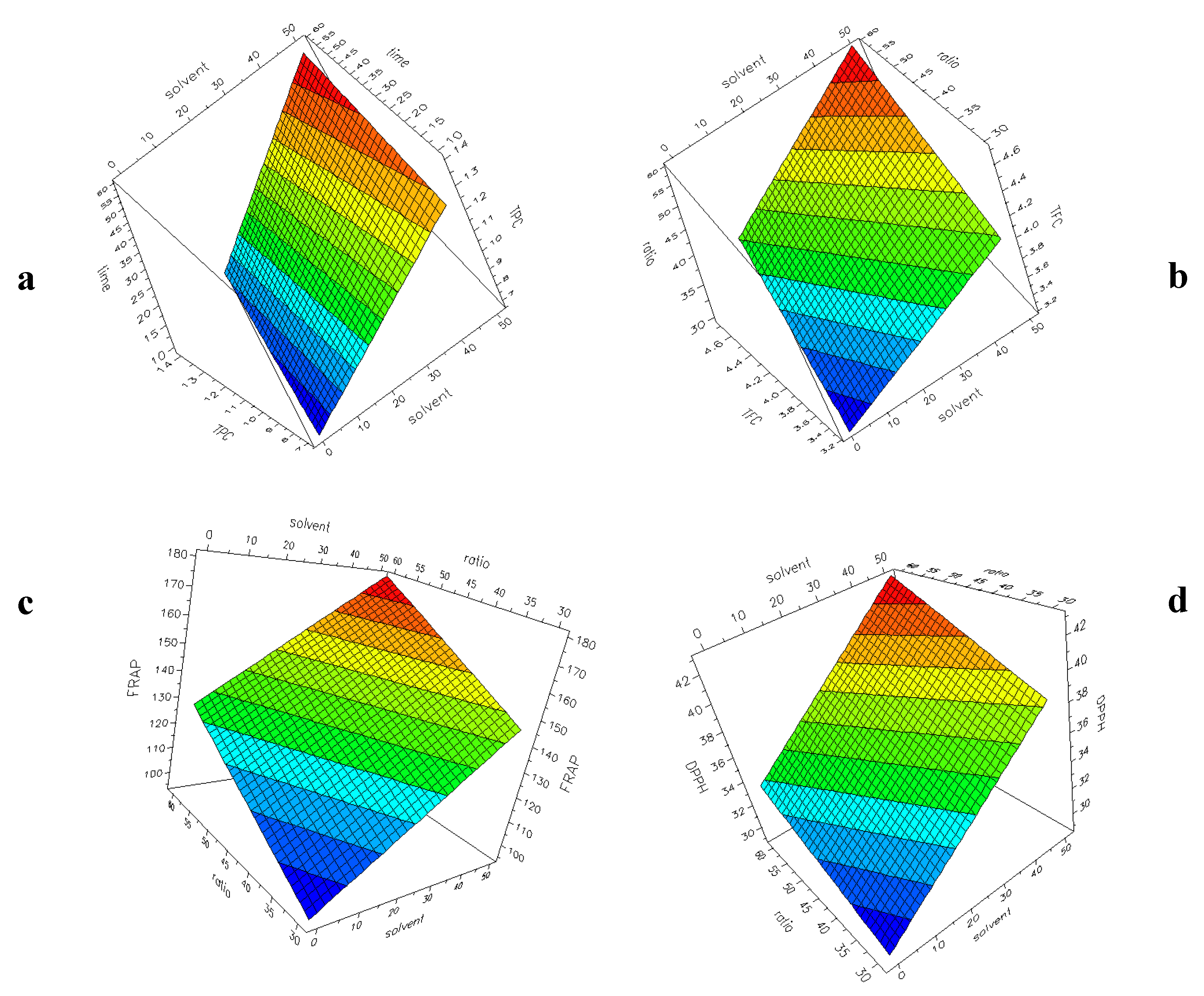3.1. Optimization of Extraction Conditions of Phenols from Moringa Leaves by UAE
The optimization study was performed by experimental design, a technique for planning experiments, that allows us to use a minimum number of experiments in which several experimental parameters vary simultaneously. Based on the obtained data, a mathematical model of the studied process is created. The model can be used to understand the influence of the experimental parameters on the response and to find the optimal conditions for the process [
27]. Regardless of application domain, this methodology is useful for three objectives: screening, optimization, and robustness testing. Employed at the beginning of the investigation of a new application, screening experiments are commonly designed to explore many factors in order to evaluate their effects on the responses. Response surface methodology (RSM) is an approach based on mathematical and statistical techniques that is useful in designing experiments and evaluating the effects of factors. RSM, a useful tool to build empirical models and to determine the optimum conditions for a desirable response, has been widely used for various process optimizations [
28,
29], including the extraction of phenol from plants [
7,
23,
30].
To evaluate the influence of UAE conditions of
Moringa leaves on total phenol content (TPC), total flavonoid content (TFC) and antioxidant activity (FRAP, DPPH), the software MODDE 5.0
TM was used. In this work, pure methanol and hydroalcoholic solution (methanol/water 50:50, v/v) were used as extraction solvents. The solvent/dry leaves ratio (mL/g DM), indicated as the liquid/solid ratio (L/S), is also an influential parameter on extraction results and the ratios of 60:1 and 30:1 have been considered. Other important parameters affecting the extraction results were considered, such as time (ranging from 10 to 60 min) and temperature (ranging from 30 and 60 °C). Selecting the screening objective and a fractional factorial design of IV resolution, the worksheet reported in the
Table 3 was obtained. The experiments N1–N11 have been carried out, and the TPC, TFC and antioxidant activity (DPPH and FRAP) have been determined. The obtained results are shown in
Table 4.
3.2. Model Statistics
Table 5 shows the coefficients and the relative standard errors and p-values for TPC, TFC, FRAP and DPPH responses. It is possible to observe that the solvent and L/S ratio variables were significant for all the considered responses. Moreover, temperature was also significant for TPC and FRAP responses while time was variable for DPPH.
The quality of the obtained mathematical model can be evaluated by two statistical criteria, goodness of fit (R
2) and goodness of predictability (Q
2). The first describes how well the model fits the experimental data, while the second describes how well the model will predict new data. When R
2 and Q
2 values are close to the unit, the model is considered a good model and it can be used for optimization and prediction [
27].
Table 6 shows the R
2 and Q
2 values of the statistical models obtained with the four responses from the UAE experiments. It is possible to observe that all values are sufficiently high (R
2 values were always higher than 0.897, while Q
2 values were always higher than 0.706), and for this reason they indicate the goodness-of-fit of the obtained statistical models.
Figure 1a–d shows the observed vs. predicted UAE plots for the four responses, respectively. The observed vs. predicted plot for a response can be used for the estimation of the quality of a model—for a good model, all the data points will fall on a straight line. The obtained plots indicate quite good models for all responses in the UAE experimental design.
3.3. Factor Influence on Responses
Previous research carried out on vegetable sources has shown that factors such as solvent properties and volume, extraction time and temperature, and frequency and power of the ultrasound apparatus influence the extraction efficiency, and subsequently have an impact on the bioactivity of the extract [
3,
9,
15]. In this research, when the model was built, some relevant factors (%H
2O, L/S ratio, temperature, and time) were investigated and in
Figure 2, the coefficient plots show the effect of the considered factors on the four responses (TPC, TFC, FRAP and DPPH). In all plots, it is evident that the solvent composition is the most influential factor among the ones considered. In fact, all four considered responses increased when the percentage of water increased in the solvent (50% v/v). Generally, hydroalcoholic extracts had higher TPC values than methanolic ones (
p < 0.01), independently from the other variables. Among extraction conditions, the solvent has great influence on the extract composition and antioxidant activity, as reported by various authors [
4,
30].
Also, TFC content was significantly higher in hydroalcoholic than methanolic extracts (p < 0.05). L/S ratio was also an influential factor, but only in the case of TFC were the bars of solvent and L/S ratio comparable, so the two parameters showed a comparable influence on the extraction.
A positive influence on the extraction results (TPC and DPPH) was also obtained for the factors time and temperature. The statistical models showed that high time (60 min) and temperature (60 °C) during extraction lead to higher TPC and DPPH values. In fact, the Optimizer function (criterion Maximize) gave the best value of TPC (13.79 mg GAE/g DM) and DPPH (43.32%) using the following conditions: 50% H2O, 60:1 L/S ratio, 60 min and 60 °C. On the other hand, it must be taken into account that high temperatures could lead to negative changes for compounds in the considered matrix.
Generally, time has very little influence on the responses. In fact, with the exception of DPPH, the coefficient is slightly positive for TPC, slightly negative for FRAP and almost null for TFC. Temperature showed a negative effect on TFC and FRAP responses. In fact, the Optimizer function (criterion Maximize) gave the best value of TFC (4.75 mg QE/g DM) using the following conditions: 50% H2O, 60:1 L/S ratio, 32 min and 30 °C, while the best value of FRAP (180.99 µmol Fe+2/g DM) was obtained using the following conditions: 50% H2O, 1:60 L/S ratio, 10 min and 30 °C.
Zhao et al. [
7] reported that the best extraction conditions were ethanol 70%, 1:30 solid/liquid ratio, 50 °C temperature and 42 min time when using ultrasonic circulating extraction equipment at 300 W. Different optimal conditions (1:52 solid/liquid ratio, 43 min and 76 °C) were obtained for maximizing the extraction of flavonoids from
M. oleifera using an ultrasonic bath cleaner at 40 KHz and 300 W [
10].
Figure 3a–d shows the surface plots with the four responses (TPC, TFC, FRAP, DPPH) as a function of two selected factors for UAE experiments. The plots have been generated by the software, setting a constant value for the other factors. The response–surface plot is generated to obtain a graphical representation of the experimental region. From this plot, the most interesting area can be used to verify experiments and to plan new experiments. The colour changing from blue to red indicates an increase in the response. It is evident that in all the considered models, an increase of H
2O% into the solvent and a higher L/S ratio (60:1) correspond to an increase in the responses, as already highlighted during the discussion of the coefficients reported in
Figure 2a–d.
3.4. Comparison with Literature Data (TPC and TFC)
It is known that differences in TPC, TFC and antioxidant activity in plant materials depend on cultivar, growing environment, extraction method, and so on [
15,
23].
Based on the condition of UAE extraction,
M. oleifera leaves showed TPC values ranging from 3.9 to 13.4 mg GAE/g DW (
Table 4; N1 and N8, respectively). The highest TPC value was obtained using the following conditions: hydroalcoholic solvent, 60:1 ratio, 60 min and 60 °C. Generally, the samples obtained with 50% H
2O showed higher TPC values (10.4–13.4 mg GAE/g DW) than those obtained with pure MeOH (3.9–7.7 mg GAE/g DW). Other authors have studied the influence of the extraction solvent on TPC yield from
M. oleifera leaves. For example, Rodríguez-Pérez et al. [
30] have reported that the presence of water in the extraction solvent gave higher TPC results, with values of 46 mg GAE/g DW using MeOH:H
2O (50:50) and 23.2 mg GAE/g DW using MeOH, for samples collected in Madagascar. However, it is important to observe that the extracts were first obtained by maceration and then by four successive UAE extractions. The same authors [
5] have optimized the MAE extraction conditions to obtain phenol compounds from the same
M. oleifera leaves and reported higher TPC values with a 50% hydroethanolic mixture (105.70 mg GAE/g DM) than those reported for ethanolic extracts (23.69 mg GAE/g DM). It should be noted that the cited results have been obtained by MAE extraction at 180 °C.
TPC values similar to those obtained in this research (
Table 4) were reported by Castro-Lopez et al. [
15] for
M. oleifera leaves collected in Mexico. They used UAE with deionized water (40 kHz; 60 min; 25 °C) and obtained about 3 mg GAE/g DW with a 1:25 solid/liquid ratio and about 12 mg GAE/g DW with a 1:50 solid/liquid ratio.
Generally, the TPC values of M. oleifera leaves reported in other studies are higher, but in many cases, it is difficult to carry out real comparisons because of the very different conditions or methods used.
The TPC value of
M. oleifera leaves collected from Greece was 29.04 mg GAE/g DM with UAE, while TPC values ranged from 24.72 to 40.24 mg GAE/g DM when a pulsed electric field at room temperature was applied for 40 min [
31].
Siddhuraju and Becker [
32] studied
Moringa leaf extracts from different geographic origins. They reported values ranging from 7.43 to 12.33 g GAE/100 g DM (Nicaragua), 5.25 to 8.87 g GAE/100 g DM (India), and 6.83 to 9.76 g GAE/100 g DM (Niger), using an apparatus consisting of a round-bottom flask with an attached reflux condenser. The lower values were obtained using water extracts, while the higher ones were obtained using 80% methanol extracts.
In this work,
M. oleifera leaves showed TFC content ranging from 2.6 to 5.4 mg QE/g DM based on different UAE conditions (
Table 4; N5 and N6, respectively). For both experiments, time and L/S ratio were the same (60 min and 1:30), but %H
2O and temperature were different (alcoholic solvent and 60 °C for N5, hydroalcoholic solvent and 30 °C for N6). It should be noted that a good correlation was found between TPC and TFC values (R
2 = 0.6740).
In the literature, a wide range of TFC values has been reported: 10.14–14.07 g of rutin equivalent (RE)/g DM for
M. oleifera leaves from Central America, 3.26–5.92 g RE/g DM for samples from South Asia, and 7.32–10.19 g RE/g DM for samples from West Africa. Higher values were reported for samples from Egypt (47.04–62.53 mg QE/g DM) obtained by UAE extraction and purification of flavonoid compounds by macroporous resin [
10]. The highest value of TFC was 192.36 mg RE/g DM for young leaves of
M. oleifera from Kenya, firstly extracted with 90% ethanol for 3 h, and then re-extracted in an ultrasonic bath (200 W, 40 KHz) for 30 min [
11].
3.5. Comparison with Literature Data (Antioxidant Activity)
The interest in
Moringa leaves is due also to their antioxidant properties [
6,
7]. Therefore, in this work, the antioxidant activity of
Moringa leaves by two in vitro complementary tests, named FRAP and DPPH, was investigated. Two tests were used as only one antioxidant mechanism did not give an overview of the antioxidant potential of the bioactive compounds, hence reducing the power, and the radical inhibiting property was analysed.
The FRAP method is a simple and effective procedure based on the reduction of a ferric tripyridyltriazine complex to its ferrous, coloured form in the presence of an antioxidant. The FRAP assay directly measures the ability of antioxidants to act as reducing compounds, showing a reduction potential below the reduction potential of the Fe
3+/Fe
2+ couple.
M. oleifera leaves showed FRAP values ranging from 45.5 to 170.5 µmol Fe
+2/g DM (
Table 4) based on the different UAE conditions (N5 and N4, respectively). As already discussed for TPC, the hydroalcoholic extracts showed the highest values (from 116.4 to 170.5 µmol Fe
+2/g DM) in respect to extractions carried out with pure MeOH (79.7–115.7 µmol Fe
+2/g DM).
In regards to DPPH, the values ranged between 13.7% for N1 and 40.6% for N8 (
Table 4); the N1 and N8 extracts were produced with very different extraction conditions (methanol, 30:1, 10 min, 30 °C vs. hydroalcoholic solvent, 60:1, 60 min, 60 °C, respectively).
A correlation study showed acceptable results between TPC and DPPH values (R2 = 0.7709), TPC and FRAP values (R2 = 0.6749), and between TFC and FRAP values (R2 = 0.7411).
Castro-Lopez et al. [
15] reported values of 0.70 and 2.43 mg GAE/g DM for FRAP and values of 1.87 and 5.03 mg GAE/g DM for DPPH when using UAE with a 1:25 or 1:50 solid/liquid ratio, respectively. The same authors used other extraction methods (maceration, decoction, and MAE) and also found that a 1:50 ratio gave higher FRAP and DPPH values with respect to the 1:25 ratio. Xu et al. [
11] studied the antioxidant activities of the crude extracts of
M. oleifera and found a half maximal inhibitory concentration (IC
50) value of 1.02 mg/mL for DPPH assay, and a value of 0.99 mM Fe
2+/g for FRAP assay.
Bozinou et al. [
31] obtained a FRAP value of 71.68 µmoL ascorbic acid equivalent/g DM and 64.82 %AA (DPPH assay) for extracts from
M. oleifera from central Greece obtained with UAE at 36 °C for 15 min.
3.6. Characterization of the M. oleifera Leaf Extract: Flavonols
There is long-standing knowledge regarding phytochemicals present in different organs of
M. oleifera, but only recently, Lin et al. [
18] reviewed the current studies of the health-promoting aspects of
Moringa flavonoids on cancer, diabetes and obesity. It has been reported that flavonols are the most common flavonoids found in
Moringa. They are in abundance and linked to a wide spectrum of sugar moieties (e.g., acetyldihexose and hexose) and the glycon structures might greatly modulate the bioactivities of flavonoids [
18]. Obviously, differences in the contents of bioactive compounds are most likely due to environmental conditions, geographic origin and other factors [
32,
33,
34,
35]. In this paper, the characterization of the flavonol fraction of
Moringa leaves produced in Italy was carried out. Based on the results of optimization step,
M. oleifera leaves have been extracted under the following experimental conditions: hydroalcoholic solvent, 60:1 L/S ratio, 35 min and 45 °C.
Table 7 shows the main flavonols identified and quantified in the UAE extract of
M. oleifera leaves. In
Figure S1 the relative HPLC-DAD chromatogram is reported.
Various glycosidic forms of quercetin were identified in
M. oleifera leaves [
11,
33], but the aglyconic forms obtained after acid hydrolysis were also reported [
32,
36]. For example, quercetin and kaempferol contents changed respectively from 657 to 2749 mg/100 g DM and from 154 to 647 mg/100 g DM, considering samples from different origin (India, Niger and Nicaragua) and different extraction solvent [
32].
In this research, kaempferol and quercetin (30.1 and 65.4 µg/g DM, respectively) are minor compounds, followed by the quercetin glycosidic forms, ranging from 216.4 µg/g DM of quercetin 3-O-rhamnoside to 293.9 µg/g DM of quercetin 3-O-(6″-O-malonyl)-β-D-glucoside.
At least fourteen flavonoids were identified by UHPLC analysis coupled with qTOF-MS (quadrupole time-of-flight mass spectrometry) in
M. oleifera leaves, harvested in Namibia and South Africa [
33]. Coppin et al. [
36] identified twelve flavonoids (six kaempferol derivatives and six quercetin derivatives) in
M. oleifera leaves collected from sub-Saharan Africa using HPLC coupled with UV and mass spectrometer detection systems; the total amount of flavonoids (quercetin plus kaempferol) ranged from 0.18 g/100 g DM for indigenous Dakar samples to 1.64 g/100 g DM for
M. oleifera leaves originally developed in India and commercially available. Xu et al. [
11] identified five flavonoids (rutin, quercetin 3-O-glucoside, quercetin-acetyl-glycoside, kaempferol 3-O-glucoside, and kaempferol-acetyl-glycoside) from leaves, but also from root and seeds, of
M. oleifera collected in Kenya using LC-MS/MS.











